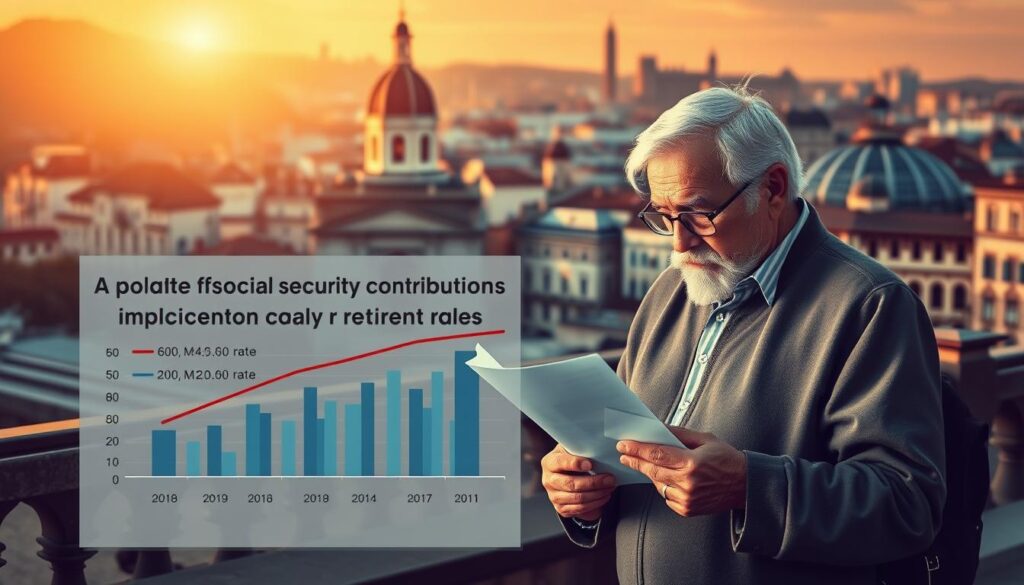Did you know that as of 2023, over 50% of private sector workers in Italy consider early retirement? This trend not only reflects a shift in personal priorities but also highlights the evolving landscape of Italy retirement policies. If you’re navigating the intricacies of early retirement age, you’re not alone. Understanding the regulations and requirements can help you make informed decisions about your future.
Key Takeaways
- Early retirement age varies across different employment sectors in Italy.
- Changes in government legislation significantly impact retirement policies.
- Pension contribution systems play a crucial role in eligibility for early retirement.
- Safe early retirement options are available for those who meet specific criteria.
- Understanding benefits can help you maximize your retirement years.
Understanding Early Retirement in Italy
Early retirement is an appealing option for many workers in Italy. It offers a chance to leave the workforce before reaching the statutory retirement age of 67. For individuals in the private sector, comprehending the nuances of the Italian retirement system is vital. This enables you to make informed decisions regarding your future.
Various alternatives exist within the framework of early retirement, including specific eligibility criteria and unique retirement benefits. For instance, workers may qualify based on their years of service and the amount contributed to the pension system. Understanding these stipulations helps ensure you can reap the maximum benefits available to you.
When considering early retirement, it’s crucial to evaluate how it impacts overall pension payouts. Leaving the workforce early may result in reduced retirement benefits. Therefore, you should weigh the immediate advantages against potential long-term consequences. Taking the time to analyze your options can lead to a more secure financial future.

Current Retirement Age Regulations
Understanding the current regulations surrounding retirement age in Italy is essential for navigating the Italian pension system. The foundational aspect to consider is the statutory retirement age, which is set at 67 years. This benchmark applies uniformly to both public and private sector employees, creating a standardized framework for all workers.
Statutory Retirement Age of 67
The statutory retirement age of 67 plays a critical role in shaping expectations and planning regarding retirement. By adhering to this age requirement, employees can ensure that they qualify for full pension benefits. It’s important to note that this policy reflects the broader trends in longevity and economic sustainability in Italy.
Recent Changes in Retirement Policies
Recent developments in retirement policies introduce nuances into the Italian pension system. Adjustments aim to accommodate various workforce dynamics, including shifts in life expectancy and labor market conditions. These changes enhance flexibility while maintaining the integrity of the statutory retirement age, providing options for those seeking earlier retirement in specific circumstances.

Early Retirement Age for Private Sector in Italy
For those working within Italy’s private sector, early retirement options have become more accessible under specific criteria. With updated regulations, you may qualify to retire early if you meet certain age requirements and have an adequate contribution history. Starting in 2024, clearer guidelines will emerge regarding these opportunities, particularly for individuals aged 63 and above.
Understanding private sector regulations can greatly influence your decision to pursue early retirement. As a general rule, if you have accumulated a minimum level of contributions, you may be eligible to retire before reaching the standard retirement age of 67. Knowing your rights and the benefits available can pave the way for a smoother transition into retirement.

Pension Contribution Systems Explained
In Italy, understanding the different pension contribution systems is vital for ensuring a comfortable retirement. Two primary systems exist: the contributory system and the retributive system. Each impacts your retirement benefits based on distinct criteria and methods of calculating pension payouts.
Contributory System (‘sistema contributivo’)
The contributory pension system is designed to allocate pension amounts based on the contributions individuals make throughout their working lives. Essentially, the more you contribute, the better your potential pension payout. This system encourages saving and continuous employment, promoting a more sustainable approach to retirement finances.
Key characteristics of the contributory system include:
- Pension payouts directly proportional to contributions.
- Incentives for longer work periods, enhancing future benefits.
- Transparency in how pensions are calculated.
Retributive System (‘sistema retributivo’)
The retributive system calculates pensions based on the average salary earned during your career instead of direct contributions. This model tends to favor those with higher salaries, providing a more favorable outcome for certain groups of workers. Understanding how this system interacts with the contributory pension system is essential for effective retirement planning.
Important aspects of the retributive system are:
- Pension is calculated based on salary averages, not just contributions.
- Potential for higher payouts for higher earners.
- Less transparency in aligning contributions with benefits.

The Role of ‘Quota 103’ in Early Retirement
Quota 103 represents a pivotal change in Italy’s early retirement policy, enabling you to access retirement benefits at the age of 62, provided you have completed at least 41 years of contributions. This model emphasizes the importance of your work history over age, making it a viable option for many workers eager to retire early.
The implementation of Quota 103 is designed to improve pension eligibility for those who have dedicated their professional lives to contributing to the pension system. This reform recognizes the varying paths individuals may take in their careers, promoting a flexible retirement framework that considers both age and contributions.

By focusing on contributions as the fundamental criterion, Quota 103 reshapes your retirement journey. It provides an opportunity for workers to step into retirement at a relatively younger age without compromising their pension benefits, ensuring financial security in later life.
Benefit of Second-Pillar Complementary Pensions
Understanding the significance of second-pillar benefits is essential for effective retirement planning. These complementary pensions are designed to provide you with an added layer of financial security as you transition into retirement. The government encourages participation in these systems to enhance overall retirement income, ensuring that your financial needs are met, especially in light of changing contributory frameworks.
By pooling funds from both employers and employees, second-pillar complementary pensions can significantly supplement your primary pension. This added financial support allows retirees to maintain their desired lifestyle, covering essential expenses and unexpected costs. Incorporating these complementary pensions into your retirement strategy can be particularly beneficial, as they offer flexibility and growth potential along with investment options tailored to meet various risk tolerances.

When considering your retirement income, it’s vital to analyze the benefits of these complementary pensions. They not only provide additional funds but also promote long-term financial planning, reducing reliance on the statutory pension system alone. As you prepare for retirement, take a moment to evaluate how second-pillar benefits can play a crucial role in achieving your financial goals.
Requirements for Early Retirement Eligibility
To enjoy the benefits of early retirement, you must meet certain requirements that ensure your readiness for this transition. Understanding the eligibility criteria is essential for planning an effective retirement strategy. Here are the key components to consider:
Minimum Contribution Period
To qualify for early retirement, you need to have a minimum contribution for early retirement. Currently, this includes a requirement of at least 25 years of contributions to the pension system. Meeting this threshold plays a crucial role in determining your eligibility for early retirement options.
Age Criteria for Private Sector Workers
The age at which you can access your retirement benefits varies. Generally, private sector workers are required to reach the age of 62 or more. Keeping track of these age criteria enables you to plan accordingly and align your career path with your retirement goals.

Special Considerations for Women’s Early Retirement
Women’s early retirement in Italy involves various benefits that recognize their unique contributions to family and society. One important aspect of this system is the tailored age reductions available specifically for mothers. These reductions can significantly impact how and when you approach your retirement planning.
Age Reductions for Mothers
Women raising children can qualify for advantageous age reductions, which allow them to retire earlier than the standard retirement age. These age reductions vary based on the number of children raised, promoting a supportive environment for family development. The policies embrace a recognition that motherhood often imposes additional responsibilities.
Additional Eligibility Criteria
In addition to age reductions, there are other criteria you’ll need to meet for women’s early retirement. These may include:
- A minimum number of years in the workforce.
- Specific contributions made to pension funds over your career.
- Consideration of any caregiving roles that affect your career trajectory.
Understanding these factors can provide you with a clearer picture of your eligibility and the benefits available for women pursuing early retirement.

Regulation Changes for 2024 and Beyond
As we approach 2024, significant regulation changes will reshape the landscape for early retirement in Italy. Understanding these changes is vital, especially concerning contribution periods and retirement timing. The adjustments make early retirement less accessible while aiming to bolster the long-term viability of the pension system.
Increasing Contribution Periods
Starting in 2024, the required minimum contribution periods for early retirement eligibility will increase from 20 to 25 years. This alteration presents a challenge for many workers nearing retirement who may currently rely on the existing conditions. The intention behind this shift focuses on strengthening the pension system, yet it could create anxiety among those close to the previous contribution benchmarks.
Moving Windows for Retirement
The upcoming regulation changes will introduce flexibility in when you can retire. These moving windows provide options to adjust your retirement date based on individual circumstances while complying with the new contribution periods. Staying informed about these changes allows you to plan ahead effectively and optimize your retirement journey.
| Aspect | Current Regulations | Regulation Changes 2024 |
|---|---|---|
| Minimum Contribution Period | 20 years | 25 years |
| Flexibility in Retirement Date | Fixed windows | Moving windows |
| Aim | Stabilizing pension system | Strengthening pension viability |

Impact of Government Policies on Retirement
Government policies play a crucial role in shaping the retirement landscape. Specifically, initiatives like financial support for caregivers offer unique advantages for those balancing work and family responsibilities. Understanding these policies helps you navigate the complexities of retirement planning.
Financial Support for Caregivers
Caregiving responsibilities can significantly affect your financial stability and retirement plans. Government assistance programs provide financial support caregivers, acknowledging the impact of caregiving on both personal income and future savings. This support can be crucial for maintaining a standard of living, especially when caregiving limits the ability to work full-time or pursue other professional opportunities.
Tax Discounts for Early Retirees
Another aspect of government policy impacting your retirement is the availability of tax discounts for early retirees. These incentives encourage individuals who qualify, such as caregivers, to transition into retirement more smoothly. By offering financial relief through tax reductions, the government aims to alleviate some financial pressure, allowing you to focus on your well-being rather than solely on monetary concerns.

| Policy Type | Benefit | Eligibility Requirements |
|---|---|---|
| Financial Support for Caregivers | Assistance with living expenses | Provided to recognized caregivers based on duration and intensity of care |
| Tax Discounts for Early Retirees | Reduction in taxable income | Eligibility varies based on retirement age and profession |
These policies illustrate the multifaceted impact on retirement, offering a crucial lifeline for many. By taking advantage of the benefits provided, you can enhance your financial position in retirement while fulfilling your caregiving role.
Social Security Contributions and Early Retirement
Understanding social security contributions is essential for anyone considering early retirement. These contributions play a pivotal role in determining both your eligibility for retirement benefits and the amount you will receive monthly. When you make contributions to the social security system, you essentially invest in your future retirement. This investment affects your pension payouts, particularly if you choose to retire before the statutory age.
Retirement implications can vary significantly based on your contribution history. Individuals with consistent contributions might enjoy better benefits, whereas gaps in contributions could lead to reduced payouts or even eligibility issues. Each year of contributions counts towards your overall benefit calculation, making it crucial to stay informed about your payment status.

Knowing the intricacies of social security contributions can empower you to make better financial decisions regarding your retirement. By planning and ensuring the right contributions, you can optimize your benefits and achieve a more secure financial future.
Potential Challenges Faced by Early Retirees
Early retirement can bring several benefits, yet it also presents unique challenges you must navigate. Understanding potential pension limitations and financial planning challenges is crucial for ensuring a smooth transition into this new phase of life. Awareness and preparedness can help you tackle these obstacles effectively.
Pension Amount Limitations
The pension amount you receive is often influenced by your work history and contributions. Early retirees may encounter pension limitations resulting from reforms and policies that impact benefit calculations. Being informed about these limitations will enable you to plan your finances accordingly and avoid unexpected shortfalls in retirement funds.
Transition from Work to Retirement
Shifting from a structured work environment to retirement can be a significant adjustment. This transition often introduces various financial planning challenges. You may need to reassess your budget, spending habits, and savings strategies to create a sustainable lifestyle after leaving the workforce. Establishing a clear plan facilitates a smoother transition and ensures you remain financially secure.

Conclusion
In summary of early retirement for private sector workers in Italy, understanding the current regulations and options is essential for effective retirement planning. As you navigate through the landscape of retirement policies such as Quota 103 and the contributory systems, staying informed will empower you to make decisions that best suit your financial needs.
It’s important to recognize how recent changes in the law, especially those set to take effect in 2024, may impact your plans. By considering the final thoughts on retirement age, you can better adapt to shifts in contribution periods and eligibility criteria, ultimately leading to a more secure future.
As you think about your retirement journey, remember that the choices you make today can shape the lifestyle you enjoy tomorrow. Embrace these insights to ensure that your transition to retirement is as smooth and fulfilling as possible.










